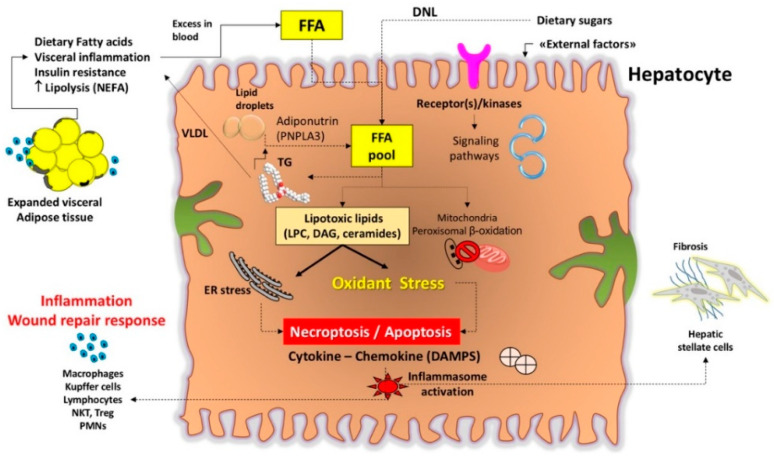Figure 3.
Mechanisms of lipotoxicity in the liver. Excessive accumulation of free fatty acids (FFA) is the result of increased influx, increased synthesis, decreased mitochondrial oxidation of FFA, or decreased secretion/export of FFA. Adiponutrin (also known as patatin-like phospholipase domain-containing protein 3, PNLPA3) governs the lipolysis of lipid droplets with FA flowing back to the hepatocyte FFA pool. With excess FFA, their disposal through beta-oxidation or formation of triglyceride is insufficient and lipotoxic species form (Lysophosphatidylcholine, LPC; diacylglycerol, DAG; ceramides) that mediate endoplasmic reticulum (ER) stress, oxidant stress and activation of the inflammasome (the multiprotein cytoplasmic complex that responds to damage-associated molecular patterns (DAMPs), as part of the innate immunity response). External factors, poorly understood so far, may include dysregulation of cytokines and adipokines, ATP depletion, toxic uric acid, sleep apnea leading to periodic hypoxia, and products of the gut microbiome (tumor necrosis factor (TNFa), endogenous ethanol, and endotoxins like lipopolysaccharides (LPS)). Such events promote the phenotype of NASH, hepatocellular injury, inflammation, stellate cell activation, and progressive accumulation of excess extracellular matrix. Further target structures of damage are other intracellular organelles, the nucleus, receptors and signaling pathways. See also [10,41,72,73].

